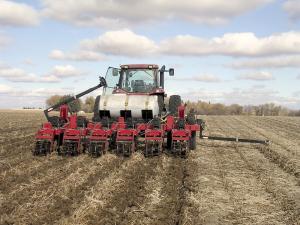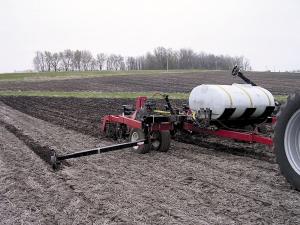He Says New Tillage System Boosted His Yields, Income
Like most farms in the 1960's, my family's operation had a wide variety of machines to produce crops. In fact, my agriculture bookkeeping records in high school showed no less than 38 items of depreciable equipment on our 200-acre farm. At least half of those were needed to plant, cultivate, spray and harvest corn and soybeans.
Flip the calendar ahead to the year 2004 and my current machine inventory is a vastly different picture. I now use only 5 pieces of equipment to till the ground, plant and harvest my soybeans and corn. This drop was due in large part to a new approach to crop production that has reduced costs, improved yields, improved soil conservation and saved time.
Until the mid-1990's I was a conventional crop farmer who believed, like my father, neighbors and many agricultural educators, that land needed to be moldboard plowed or chiseled in the fall, that residue needed to be chopped and/or buried, and that fields needed to be worked in the spring until they were table-rock smooth. Those methods for me produced average yields that held at about 175 bushels for corn and 50 bushels for soybeans. Even when I gave special attention to fertility and crop rotation in the latter 90's, my top yields never reached more than 195 for corn and 55 for soybeans.
Looking for improvements that would break through the "yield barriers", I studied tillage, fertility, planting methods and biological activity in the soil. I used no-till and twin-row beans with the Roundup« cropping system, but the soybean yield barrier held tight. I used the latest corn hybrids, new fertilizers, regular crop rotations, and twin row corn, but those barriers also held.
Three years ago I became interested in the tillage methods and fertility concepts taught by Donald Schriefer, author of Agriculture in Transition and Life in the Soil. Schriefer's concept of minimum tillage, banding nutrients, stimulating biological activity in the soil and conserving residue was markedly different. Consulting agronomists in Minnesota, Nebraska, and Iowa were also advancing these concepts. After observing that innovative farmers were winning yield contests with his approaches, I decided to give them a try.
One of the first steps I had to take was to reduce fall and spring tillage and place nutrients in a band. After looking at equipment options, I decided on a custom design that would use large shanks to slice through compaction and place liquid nutrients under the root mass of young corn and soybean plants. Although stock machines were available from three or four companies, I had a machine custom-built by Rawson Farms of Farwell, Michigan. Ray Rawson has been an innovative and conservation-minded farmer for 40 years and holds several patents for tillage equipment. This design was a modification of other equipment he has built in recent years.
Mine is a 6-row, 30-in. pull-type machine with a 6 by 6-in. box frame hitch, two sets of dual wheels, a 500-gal. liquid tank and a John Blue pump. Six lead coulters mounted on the front frame cut residue in front of the 6 deep shanks mounted on the rear 4 by 6 box frame. Beside and slightly behind each shank are two wavy coulters that can be adjusted to throw soil into a slight berm, which is leveled by a rolling basket.
I use this "Zone Tool" in the fall on soybean stubble to place liquid nutrients and biological products about 14 in. deep on 30-in. row spacing. This is ground that's planted to corn the following spring. I've also used the machine in cornstalks, doing primary tillage on 30-in. centers between standing stalks. Depending on the nutrients and biological products I'm placing, I'll run from 10 to 16 in. deep. To operate in heavy cornstalks, the rolling baskets and wavy coulters are removed, replaced with a coulter that has less aggressive soil action and handles trash better.
The Zone Tool is especially effective in the spring, accomplishing in one pass what the disk or field cultivator did in two or three passes. In soybean ground I drive on the row stubble and the shanks follow the slo

Click here to download page story appeared in.
Click here to read entire issue
He Says New Tillage System Boosted His Yields, Income TILLAGE EUIPMENT Miscellaneous 28-3-17 Like most farms in the 1960's, my family's operation had a wide variety of machines to produce crops. In fact, my agriculture bookkeeping records in high school showed no less than 38 items of depreciable equipment on our 200-acre farm. At least half of those were needed to plant, cultivate, spray and harvest corn and soybeans.
Flip the calendar ahead to the year 2004 and my current machine inventory is a vastly different picture. I now use only 5 pieces of equipment to till the ground, plant and harvest my soybeans and corn. This drop was due in large part to a new approach to crop production that has reduced costs, improved yields, improved soil conservation and saved time.
Until the mid-1990's I was a conventional crop farmer who believed, like my father, neighbors and many agricultural educators, that land needed to be moldboard plowed or chiseled in the fall, that residue needed to be chopped and/or buried, and that fields needed to be worked in the spring until they were table-rock smooth. Those methods for me produced average yields that held at about 175 bushels for corn and 50 bushels for soybeans. Even when I gave special attention to fertility and crop rotation in the latter 90's, my top yields never reached more than 195 for corn and 55 for soybeans.
Looking for improvements that would break through the "yield barriers", I studied tillage, fertility, planting methods and biological activity in the soil. I used no-till and twin-row beans with the Roundup« cropping system, but the soybean yield barrier held tight. I used the latest corn hybrids, new fertilizers, regular crop rotations, and twin row corn, but those barriers also held.
Three years ago I became interested in the tillage methods and fertility concepts taught by Donald Schriefer, author of Agriculture in Transition and Life in the Soil. Schriefer's concept of minimum tillage, banding nutrients, stimulating biological activity in the soil and conserving residue was markedly different. Consulting agronomists in Minnesota, Nebraska, and Iowa were also advancing these concepts. After observing that innovative farmers were winning yield contests with his approaches, I decided to give them a try.
One of the first steps I had to take was to reduce fall and spring tillage and place nutrients in a band. After looking at equipment options, I decided on a custom design that would use large shanks to slice through compaction and place liquid nutrients under the root mass of young corn and soybean plants. Although stock machines were available from three or four companies, I had a machine custom-built by Rawson Farms of Farwell, Michigan. Ray Rawson has been an innovative and conservation-minded farmer for 40 years and holds several patents for tillage equipment. This design was a modification of other equipment he has built in recent years.
Mine is a 6-row, 30-in. pull-type machine with a 6 by 6-in. box frame hitch, two sets of dual wheels, a 500-gal. liquid tank and a John Blue pump. Six lead coulters mounted on the front frame cut residue in front of the 6 deep shanks mounted on the rear 4 by 6 box frame. Beside and slightly behind each shank are two wavy coulters that can be adjusted to throw soil into a slight berm, which is leveled by a rolling basket.
I use this "Zone Tool" in the fall on soybean stubble to place liquid nutrients and biological products about 14 in. deep on 30-in. row spacing. This is ground that's planted to corn the following spring. I've also used the machine in cornstalks, doing primary tillage on 30-in. centers between standing stalks. Depending on the nutrients and biological products I'm placing, I'll run from 10 to 16 in. deep. To operate in heavy cornstalks, the rolling baskets and wavy coulters are removed, replaced with a coulter that has less aggressive soil action and handles trash better.
The Zone Tool is especially effective in the spring, accomplishing in one pass what the disk or field cultivator did in tw
To read the rest of this story, download this issue below or click
here to register with your account number.








